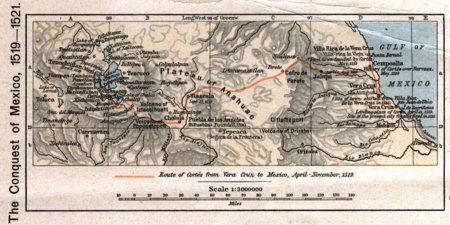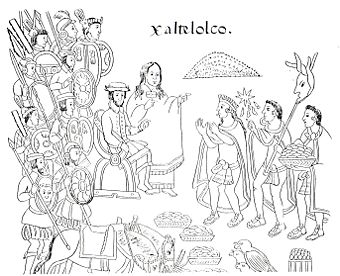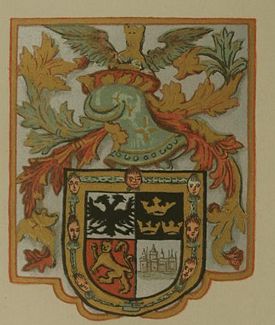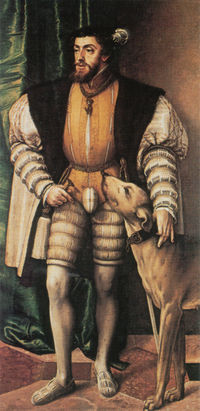Hernán Cortés
2008/9 Schools Wikipedia Selection. Related subjects: Historical figures
| Hernán Cortés | |
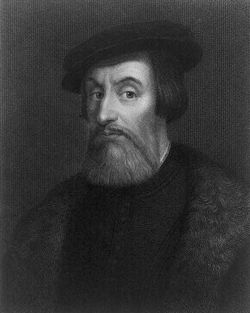 Hernán Cortés in a contemporary rendition
|
|
| Born | 1485 Medellín, Badajoz, Extremadura, Spain |
|---|---|
| Died | December 2, 1547 Castilleja de la Cuesta, Seville, Andalusia, Spain |
Hernán Cortés de Monroy y Pizarro, 1st Marqués del Valle de Oaxaca ( 1485– December 2, 1547) was a Spanish conquistador who initiated the conquest of the Aztec Empire on behalf of Charles V, king of Castile and Holy Roman Emperor, in the early 16th century. Cortés was part of the generation of Spanish colonizers that began the first phase of the Spanish colonization of the Americas.
Born in Medellín, Extremadura, in Castile, to a family of lesser nobility, Cortés chose to pursue a livelihood in the New World. He went to Hispaniola and later to Cuba, where he received an encomienda and, for a short time, became alcalde (mayor) of a small town. In 1519, he was elected captain of the third expedition to the mainland, an expedition which he partly funded. His enmity with the governor of Cuba, Diego Velázquez de Cuéllar, resulted in the latter recalling the expedition at the last moment, an order which Cortés ignored. Arriving on the continent, Cortés executed a successful strategy of allying with some indigenous peoples against others. He also used a native woman, Doña Marina, as interpreter; she would later bear Cortés a son. When the Governor of Cuba sent emissaries to arrest Cortés, he fought them and won, using the extra troops as reinforcements. Cortés wrote letters directly to the king asking to be acknowledged for his successes instead of punished for mutiny. After he overthrew the Aztec empire, Cortés was awarded the title of Marqués del Valle de Oaxaca, while the more prestigious title of Viceroy was given to a high-ranking nobleman, Antonio de Mendoza. Cortés returned to Spain in 1541 where he died peacefully but embittered.
Because of the controversial undertakings of Cortés and the scarcity of reliable sources of information about him, it has become difficult to assert anything definitive about his personality and motivations. Early lionizing of the conquistadors did not encourage deep examination of Cortés. Later reconsideration of the conquistadors' character in the context of modern anti-colonial sentiment and greatly expanded concern for human rights, as typified by the Black Legend, also did little to expand our understanding of Cortés as an individual. As a result of these historical trends, descriptions of Cortés tend to be simplistic, and either damning or idealizing.
Name
While he is now often referred to as Hernán Cortéz, in his time he called himself Hernando Cortés or Fernando Cortés. In Castillian Spanish, z and s are different sounds (/s/ and /θ/, respectively). And (in Spanish) Cortés's name has the s sound. Even so, the English pronunciation of his name is IPA: [kɔrˈtɛz], enPR: kôr-tĕzʹ (in Spanish, however, his name is pronounced IPA: [koɾˈtes]).
Hernán, Hernando, and Fernando all are equally correct. The latter two were most commonly used during his life time, but the former short form has become most common in both the Spanish and English languages in modern times, and is the name by which most people know him today.
Early life
Cortés was born in Medellín, in the province of Extremadura, in the Kingdom of Castile in Spain in 1485. His father, Martín Cortés de Monroy, born in 1449 son of Rodrigo or Ruy Fernández de Monroy and wife María Cortés, was an infantry captain of distinguished ancestry but slender means. His mother was Catalina Pizarro Altamirano. Through his mother, Hernán was second cousin once removed of Francisco Pizarro, who later conquered the Inca empire of modern-day Peru (not to be confused with another Francisco Pizarro who joined Cortés to conquer the Aztecs), through her parents Diego Altamirano and wife and cousin Leonor Sánchez Pizarro Altamirano, first cousin of Pizarro's father. Through his father, Hernán was a twice distant relative of Nicolás de Ovando y Cáceres, the third Governor of Hispaniola. His paternal grandfather was a son of Rodrigo de Monroy y Almaraz, 5th Lord of Monroy, and wife Mencía de Orellana y Carvajal.
Hernán Cortés is described as a pale, sickly child by his biographer, chaplain, and friend Francisco López de Gómara. At the age of 14, Cortés was sent to study at the University of Salamanca. This was Spain's great centre of learning, and while accounts vary as to the nature of Cortés' studies, his later writings and actions suggest he studied Law and probably Latin.
After two years, Cortés, tired of schooling, returned home to Medellín, much to the irritation of his parents, who had hoped to see him equipped for a profitable legal career. However, those two years at Salamanca, plus his long period of training and experience as a notary, first in Seville and later in Hispaniola, would give him a close acquaintance with the legal codes of Castile that was to stand him in good stead in justifying his unauthorized conquest of Mexico.
At this point in his life, Cortés was described by Gómara as restless, haughty, and mischievous. This was probably a fair description of a sixteen-year-old boy who had returned home only to find himself frustrated by life in his small provincial town.
By this time, news of the exciting discoveries of Columbus in the New World was streaming back to Spain.
Departure for the New World
Plans were made in 1502 for Cortés to sail to the Americas with a family acquaintance and distant relative, Nicolás de Ovando y Cáceres, the newly appointed governor of Hispaniola (currently Haiti and the Dominican Republic), but an injury he sustained while hurriedly escaping from the bedroom of a married woman of Medellín prevented him from making the journey. Instead, he spent the next year wandering the country, probably spending most of his time in the heady atmosphere of Spain's southern ports, listening to the tales of those returning from the Indies, who told of discovery and conquest, gold, Indians and strange unknown lands.
Arrival
Cortés did not arrive in the " New World" until he finally succeeded in reaching Hispaniola in a ship commanded by Alonso Quintero, who tried to deceive his superiors and reach the New World before them in order to secure personal advantages. Quintero's mutinous conduct may have served as a model for Cortés in his subsequent career. The history of the conquistadores is rife with accounts of rivalry, jockeying for position, mutiny, and betrayal.
Upon his arrival in 1503 in Santo Domingo, the capital of Hispaniola, the eighteen-year-old Cortés registered as a citizen, which entitled him to a building plot and land for cultivation. Soon afterwards, Ovando, still the governor, gave him a repartimiento of Indians and made him a notary of the town of Azuza. His next five years seem to have served to establish him in the colony; in 1506, Cortés took part in the conquest of Hispaniola and Cuba, receiving a large estate of land and Indian slaves for his efforts.
Cortés in Cuba
In 1510, he accompanied Diego Velázquez de Cuéllar, an aide of the governor of Hispaniola, in his expedition to conquer Cuba. At the age of 26, Cortés was made clerk to the treasurer with the responsibility of ensuring that the Crown received the quinto, or customary one-fifth of the profits from the expedition.
The governor of Cuba, Diego Velázquez, was so impressed with Cortés that he secured a high political position for him in the colony. Cortés continued to build a reputation as a daring and bold leader. He became secretary for Governor Velázquez. Cortes was appointed mayor ( alcalde) of Santiago. In Cuba, Cortés became a man of substance with a repartimiento of Indians, mines and cattle. In 1514, Cortés led a group demanding that more Indians be assigned to the settlers.
As time went on, relations between Cortés and governor Velázquez became strained. The governor twice jailed the young cavalier although each time Cortés managed to escape.
Cortés also found time to become romantically involved with Catalina Xuárez (or Juárez), the sister-in-law of Governor Velázquez. Part of Velázquez' displeasure seems to have been based on a belief that Cortés was trifling with Catalina's affections. Cortés was temporarily distracted by one of Catalina's sisters but finally married Catalina, reluctantly, under pressure from Governor Velázquez. However, by doing so, he hoped to secure the good will of both her family and that of Velázquez .
It was not until he had been almost 15 years in the Indies, that Cortés began to look beyond his substantial status as mayor of the capital of Cuba and as a man of affairs in the thriving colony. He missed the first two expeditions, under the orders of Francisco Hernández de Córdoba and then Juan de Grijalva, sent by Diego Velázquez to Mexico in 1517-1518.
The Invasion of Mexico
In 1518 Velázquez put him in command of an expedition to explore and secure the interior of Mexico for colonization. At the last minute, due to the old gripe between Velázquez and Cortés, he changed his mind and revoked his charter. Cortés ignored the orders and went ahead anyway, in February 1519, in an act of open mutiny. He landed along with 600 men in the Yucatan Peninsula, in Mayan territory . There, he met Jeronimo de Aguilar, a Spaniard who had survived from a shipwreck and joined the troops . Jeronimo de Aguilar, a Franciscan priest, had learnt Maya during his captivity, and could thus translate for Cortés. In March 1519, Cortés formally claimed the land for the Spanish crown. He then won a battle against the Natives of Tabasco, during which he received from the vanquished twenty young indigenous women, among whom was La Malinche, his future mistress, who knew both the Nahuatl language and Maya, thus enabling Hernán Cortés to communicate in both.
In July 1519, his men took over Veracruz: by this act, Cortés dismissed the authority of the governor of Cuba to place himself directly under the orders of Charles V . Leaving a hundred men in Veracruz, Cortès marched on Tenochtitlan in mid-August 1519, along with 400 men, 15 horsemen, 15 cannons, and hundreds of indigenous carriers and warriors . On the way to Tenochtitlan, Cortés made alliances with native American polities such as the Nahuas of Tlaxcala, the Tlaxcaltec (defeated in a battle and then made allies), and the Totonacs of Cempoala. In October 1519, Cortés and his men, accompanied by about 3,000 Tlaxcalteca, marched to Cholula, the second largest city in central Mexico. Cortés, either in a pre-meditated effort to instill fear upon the Aztecs waiting for him at Tenochtitlan or (as he later claimed when under investigation) wishing to make an example when he feared native treachery, infamously massacred thousands of unarmed members of the nobility gathered at the central plaza, then partially burning down the city.
By the time he arrived in Tenochtitlan the Spaniards had a large army. On 9 November 1519, they were peacefully received by the Aztec Emperor Moctezuma II. The latter deliberately let Cortés enter the heart of the Aztec Empire, hoping to get to know their weaknesses better and to crush them later . He gave lavish gifts in gold to the Spaniards which enticed them to plunder vast amounts of gold. In his letters to Charles V, Cortés claims to have learned at this point that he was considered by the Aztecs to be either an emissary of the feathered serpent god Quetzalcoatl or Quetzalcoatl himself — a belief which has been contested by some modern historians . But quickly Cortès learnt that Spaniards on the coast had been attacked, and decided to take Moctezuma into hostage in his own house, requesting him to swear allegiance to Charles V.
Meanwhile, the Governor of Cuba sent another expedition, lead by Pánfilo de Narváez, to oppose Cortès, arriving in Mexico in April 1520 with 1,100 men . Cortès henceforth decided to leave Tenochtitlan to fight Narváez, whom he overcame despite his numerical inferiority . In Mexico, one of Cortès' lieutenants Pedro de Alvarado, committed a massacre in the Main Temple, triggering a local rebellion. Cortès speedily returned to Mexico and proposed an armistice, attempting to support himself on Moctezuma, but the latter was killed by his subjects on July 1, 1520, and Cortès decided to flee for Tlaxcala. During the Noche Triste (30 June-1st July 1520), the Spaniards managed to escape from Mexico, while their backguard was being massacred. Much of the treasure looted by Cortés was lost (as well as his artillery) during this panicked escape from Tenochtitlan . After a battle in Otumba, they managed to reach Tlaxcala, after having lost 870 men . With the assistance of their allies, Cortès' men finally prevailed with reinforcements arriving from Cuba. Cortés began a policy of attrition towards the island city of Tenochtitlan cutting off supplies and subduing the Aztecs' allied cities thus changing the balance, and organizing the siege of Tenochtitlan, destroying the city.
In January 1521, Cortès countered a conspiracy against him, headed by Villafana, who was hanged . Finally, with the capture of Cuauhtémoc, the Tlatoani (ruler) of Tenochtitlan, on 13 August 1521, the Aztec Empire disappeared. From 1521 to 1524, Cortés personally governed Mexico .
Appointment to governorship of Mexico and internal dissensions
Many historical sources have conveyed an impression that Cortés was unjustly treated by the Spanish Crown, and that he received nothing but ingratitude for his role in establishing New Spain. This picture is the one Cortés presents in his letters and in the later biography written by Gomara. However, there may be more to the picture than this. Cortés' own greed and vanity may have played a part in his deteriorating position with the King
- "Cortés personally was not ungenerously rewarded, but he speedily complained of insufficient compensation to himself and his comrades. Thinking himself beyond reach of restraint, he disobeyed many of the orders of the Crown, and, what was more imprudent, said so in a letter to the emperor, dated 15 October 1524 (Ycazbalceta, "Documentos para la Historia de México", Mexico, 1858, I). In this letter Cortés, besides recalling in a rather abrupt manner that the conquest of Mexico was due to him alone, deliberately acknowledges his disobedience in terms which could not fail to create a most unfavourable impression."
King Charles I of Spain, who had become Holy Roman Emperor Charles V in 1519, appointed Cortés governor and captain general of the newly conquered territory, dubbed " New Spain of the Ocean Sea". But also, much to the dismay of Cortés, four royal officials were appointed at the same time to assist him in his governing — in effect submitting him to close observation and administration. Cortés initiated the construction of Mexico City, destroying Aztec temples and buildings and then rebuilding on the Aztec ruins what soon became the most important European city in the Americas. Cortès managed the founding of new cities and appointed men to extend Spanish rule to all of New Spain, imposing the encomienda land tenure system in 1524 . He also supported efforts to evangelize the indigenous people to Christianity and sponsored new explorations. He then spent the next seven years establishing peace among the Indians of Mexico and developing mines and farmlands. Cortés was one of the first Spaniards to attempt to grow sugar in Mexico and one of the first to import African slaves to early colonial Mexico. At the time of his death his estate contained at least 200 slaves who were either native Africans or of African descent.
In 1523, the Crown (possibly influenced by Cortés' enemy, Bishop Fonseca), sent a military force under the command of Juan de Garay to conquer and settle the northern part of Mexico, the region of Pánuco. This was another setback for Cortés who mentions this in his fourth letter to the King in which he describes himself as the victim of a conspiracy by his archenemies Diego Velázquez, Diego Columbus and Bishop Fonseca as well as Juan Garay. The influence of Garay was effectively stopped by this appeal to the King who sent out a decree forbidding Garay to interfere in the politics of New Spain, causing him to give up without a fight.
From 1524 to 1526, Cortès headed an expedition to Honduras where he defeated Cristóbal de Olid, who had claimed Honduras as his own under the influence of the Governor of Cuba Diego Velázquez. Fearing that Cuauhtémoc might head an insurrection in Mexico, he brought him with him in Honduras and hanged him during the journey. Raging over Olid's treason, Cortès issued a decree to arrest Velázquez, whom he was sure was behind Olid's treason. This, however, only served to further estrange the Spanish Crown which was already beginning to feel anxious about Cortés' rising power.
Cortés's fifth letter to Charles V attempts to justify his conduct and concludes with a bitter attack on “various and powerful rivals and enemies” who have “obscured the eyes of your Majesty.” Unfortunately, the Holy Roman Emperor had little time for distant colonies (much of Charles's reign was taken up with wars with France, the German protestants and the expanding Ottoman Empire), except insofar as they contributed to finance his wars. In 1521, year of the Conquest, Charles V was attending to matters in his German domains and Spain was ruled by Bishop (later Pope) Adrian of Utrecht, who functioned as regent. Velázquez and Fonseca persuaded the regent to appoint a commissioner with powers, (a Juez de residencia, Luis Ponce de León), to investigate Cortés's conduct and even arrest him. Cortés was once quoted as saying that it was "more difficult to contend against (his) own countrymen than against the Aztecs." Governor Diego Velázquez continued to be a thorn in his side, teaming up with Bishop Juan Rodríguez de Fonseca, chief of the Spanish colonial department, to undermine him at court.
A few days after Cortès' return from his expedition, Ponce de León suspended Cortés from his office of governor of New Spain. The Licentiate then fell ill and died shortly after his arrival, appointing Marcos de Aguilar as alcalde mayor. The aged Aguilar also became sick and appointed Alonso de Estrada governor, who was confirmed in his functions by a royal decree in August 1527. Cortés, suspected of poisoning them, refrained from taking over the government. Estrada sent Diego de Figueroa to the south; but de Figueroa raided graveyards and extorted contributions, meeting his end when the ship carrying these treasures sunk. Albornoz persuaded Alonso de Estrada to release Salazar and Chirinos. When Cortes complained angrily after one of his adherent's hand was cut off, Estrada ordered him exiled. Cortes sailed for Spain in 1528 to appeal to Emperor Charles V.
First return to Spain (1528)
In 1528, Cortes returned to Spain to appeal to the justice of his master, Charles V. He presented himself with great splendor before the court. By this time Charles V had returned and Cortés forthrightly responded to his enemy's charges. Denying he had held back on gold due the crown, he showed that he had contributed more than the quinto (one-fifth) required. Indeed, he had spent lavishly to rebuild Tenochtitlán, damaged during the siege that brought down the Aztec empire.
He was received by Charles with every distinction, and decorated with the order of Santiago. In return for his efforts in expanding the still young Spanish Empire, Cortés was rewarded in 1529 by being named the "Marqués del Valle de Oaxaca" (Marquis of the Oaxaca Valley), a noble title and senorial estate which was passed down to his descendants until 1811. The Oaxaca Valley was one of the wealthiest region of New Spain, and Cortés had 23 000 vassals . Although confirmed in his land holdings and vassals, he was not reinstated as governor and was never again given any important office in the administration of New Spain. During his travel to Spain, his property was mismanaged by abusive colonial administrators. He sided with local Indians in a lawsuit. The Indians documented the abuses in the Huexotzinco Codex.
Return to Mexico
Cortés returned to Mexico in 1530 with new titles and honours, but with diminished power, a viceroy, Antonio de Mendoza, having been entrusted in 1535 with the administration of civil affairs, although Cortés still retained military authority, with permission to continue his conquests. This division of power led to continual dissension, and caused the failure of several enterprises in which Cortés was engaged.
On returning to Mexico, Cortés found the country in a state of anarchy. At a time when there was a strong suspicion in court circles of an intended rebellion by Cortés, a charge was brought against him that cast a fatal blight upon his character and plans. He was accused of murdering his first wife. The proceedings of the investigation were kept secret. No report, either exonerating or condemning Cortés, was published. Had the Government declared him innocent, it would have greatly increased his popularity; had it declared him a criminal, a crisis would have been precipitated by the accused and his party. Silence was the only safe policy, but that silence is suggestive that grave danger was feared from his influence.
After reasserting his position and reestablishing some sort of order, Cortés retired to his estates at Cuernavaca, about 30 miles (48 km) south of Mexico City. There he concentrated on the building of his palace and on Pacific exploration. Remaining in Mexico between 1530 and 1541, Cortés quarreled with Nuño Beltrán de Guzmán and disputed the right to explore the territory that is today California with Antonio de Mendoza, the first viceroy. In 1536, Cortés explored the northwestern part of Mexico and discovered the Baja California peninsula. Cortés also spent time exploring the Pacific coast of Mexico. The Gulf of California was originally named the Sea of Cortes by its discoverer Francisco de Ulloa in 1539. This was the last major expedition by Cortés.
Later life and death
Second return to Spain
After his exploration of Baja California, Cortés returned to Spain in 1541, hoping to confound his angry civilians, who had brought many lawsuits against him (for debts, abuse of power, etc. ).
On his return he was utterly neglected, and could scarcely obtain an audience. On one occasion he forced his way through a crowd that surrounded the emperor's carriage, and mounted on the footstep. The emperor, astounded at such audacity, demanded of him who he was. "I am a man," replied Cortés proudly, "who has given you more provinces than your ancestors left you cities."
Expedition against Algiers
The emperor finally permitted Cortés to join himself and his fleet commanded by Andrea Doria at the great expedition against Algiers in the Barbary Coast in 1541, which was then part of the Ottoman Empire and was used as a base by the notorious Turkish corsair Barbarossa Hayreddin Pasha who was also the Admiral-in-Chief of the Ottoman Fleet. During this unfortunate campaign, which was his last, Cortés was almost drowned in a storm that hit his fleet while he was pursuing Barbarossa Hayreddin Pasha, who managed to defeat the fleet of Charles V for a second time after the 1538 Battle of Preveza.
Final Days and Death
Having spent a great deal of his own money to finance expeditions, he was now heavily in debt. In February 1544 he made a claim on the royal treasury, but was given a royal runaround for the next three years. Disgusted, he decided to return to Mexico in 1547. When he reached Seville, he was stricken with dysentery. He died in Castilleja de la Cuesta, Seville province, on December 2, 1547, from a case of pleurisy at age 62.
Like Columbus, he died a wealthy but embittered man. He left his many mestizo and white children well cared for in his will, along with every one of their mothers. He requested in his will that his remains eventually be buried in Mexico. Before he died he had the Pope remove the "natural" status of three of his children (legitimizing them in the eyes of the church), including Martin, the son he had with Doña Marina (also known as La Malinche), said to be his favorite.
Children
Natural children of Hernán Cortés:
- don Martín Cortés, son of doña Marina (La Malinche), called the First Mestizo; about him was written The New World of Martín Cortés; married doña Bernaldina de Porras and had two children:
- doña Ana Cortés
- don Fernando Cortés, Principal Judge of Veracruz. Descendants of this line are alive today in Mexico.
- don Luis, son of doña Antonia Hermosillo
- doña Catalina Pizarro, daughter of his relative doña Leonor Pizarro
- doña Leonor, daughter of doña Isabel de Moctezuma, the oldest legitimate daughter of Moctezuma II Xocoyotzin
- doña María Cortés de Moctezuma, married to don Juan de Tolosa, a miner, daughter of Mexica (Aztec) princess Tecuichpotzin Xocoyotzin, born in Tenochtitlan on July 11, 1510 and died on July 9, 1550, daughter of Moctezuma II Xocoyotzin and wife doña María Miahuaxuchitl
He married twice: firstly in Cuba to Catalina Juárez Marcaida, who died at Coyoacán in 1522, without issue, and secondly in 1529 to doña Juana Ramírez de Arellano de Zúñiga, daughter of don Carlos Ramírez de Arellano, 2nd Count of Aguilar and wife the Countess doña Juana de Zúñiga, and had:
- don Luis Cortés y Ramírez de Arellano, who died a child in Texcoco in 1530
- doña Catalina Cortés de Zúñiga, who died a short time after birth in 1531
- don Martín Cortés y Ramírez de Arellano, 2nd Marquis of the Valley of Oaxaca, born in Cuernavaca in 1532, married at Nalda on February 24, 1548 his twice cousin once removed doña Ana Ramírez de Arellano y Ramírez de Arellano and had issue, currently extinct in male line
- doña María Cortés de Zúñiga, born between 1533 and 1536, married to don Luis de Quiñones y Pimentel, 5th Count of Luna
- doña Catalina Cortés de Zúñiga, born between 1533 and 1536, died unmarried in Sevilla after the funeral of her father
- doña Juana Cortés de Zúñiga, born between 1533 and 1536, married Don Fernando Enríquez de Ribera y Portocarrero, 2nd Duke of Alcalá de los Gazules, 3rd Marquess of Tarifa and 6th Count of Los Molares, and had issue
Disputed interpretation of the life of Cortés
There are relatively few sources to the early life of Cortés; his fame arose from his participation in the conquest of Mexico and it was only after this that people became interested in reading and writing about him. Probably the best source is his letters to the king which he wrote during the campaign in Mexico, but they are written with the specific purpose of putting his efforts in a favourable light and so must be read critically. Another main source is the biography written by Cortés' private chaplain Lopez de Gómara, which was written in Spain several years after the conquest. Gómara never set foot in the Americas and knew only what Cortés had told him, and he had an affinity for knightly romantic stories which he incorporated richly in the biography. The third major source is written as a reaction to what its author calls "the lies of Gomara", the account written by the Conquistador Bernal Díaz del Castillo does not paint Cortés as a romantic hero but rather tries to emphasize that also Cortés' men should be remembered as important participants in the undertakings in Mexico. In the years following the conquest also more critical accounts of the Spanish arrival in Mexico were written. The Dominican friar Bartolomé de Las Casas wrote his A Short Account of the Destruction of the Indies in which he raised strong accusations of brutality, and heinous violence towards the Indians against the conquistadors in general and Cortés in particular. The accounts of the conquest given in the Florentine Codex by the Franciscan Bernardino de Sahagún and his native informants are also less than flattering towards Cortés. The result of the scarce sources to the life of Cortés has been sharp divisions in the description of Cortés' personality and a tendency to describe him as either a vicious and ruthless person or a noble and honorable cavalier.
Assessment of Cortés
It is extremely difficult to characterize this particular conquistador – his atrocities, his tactical and strategic awareness, the rewards for his Tlaxcalteca allies along with the rehabilitation of the nobility (including a castle for Moctezuma's heirs in Spain that still stands), his respect for Indians as worthy adversaries and family members.
Cortés's place in Mexican history
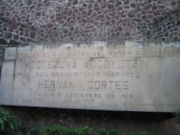
The muralist Diego Rivera depicts him as deformed and a bit seasick. However, many landmarks still bear his name, from the castle in the city of Cuernavaca to some street names throughout the republic.
The only authentic momuments are in the Hospital de Jesús Nazareno in Mexico City are at the pass between the volcanoes Ixccahiautl and Popocatepetl where Cortes took his soldiers on their march to Mexico City. It is known as the Paso de Cortes.
His and his family crypt is at the Hospital de Jesús Nazareno in Mexico City. However, his body has been moved more than eight times to avoid destruction. Today, (and unknown to most Mexicans) it is in the "Templo de Jesús" in Mexico City with the only statue of Cortés in Mexican territory, a statue by Manuel Tolsá. In 1981 the statue and the body were in danger of destruction by a nationalistic group, after the statue was made public by President López Portillo, so access had to be restricted.
Writings - The Cartas de Relación
Cortés' personal account of the conquest of Mexico is narrated in his five letters addressed to Charles V, the Holy Roman Emperor. These five letters, or cartas de relación, are Cortés' only surviving writings. See "Letters and Dispatches of Cortés," translated by George Folsom (New York, 1843); Prescott's "Conquest of Mexico" (Boston, 1843); and Sir Arthur Helps's "Life of Hernando Cortes" (London, 1871).
As one specialist describes them...
"The Cartas de relación have enjoyed an unequaled popularity among students of the Conquest of Mexico. Cortés was a good writer. His letters to the emperor, on the conquest, deserve to be classed among the best Spanish documents of the period. They are, of course, coloured so as to place his own achievements in relief, but, withal, he keeps within bounds and does not exaggerate, except in matters of Indian civilization and the numbers of population as implied by the size of the settlements. Even there he uses comparatives only, judging from outward appearances and from impressions. Historians, sociologists, and political scientists use them to glean information about the Aztec empire and the clash between the European and Indian cultures. However, as early as the sixteenth century doubt has been cast on the historicity of these Conquest accounts. It is generally accepted that Cortés does not write a true “history,” but rather combines history with fiction. That is to say, in his narrative Cortés manipulates reality in order to achieve his overarching purpose of gaining the favour of the king. Cortés applies the classical rhetorical figure of evidentia as he crafts a powerful narrative full of “vividness” that moves the reader and creates a heightened sense of realism in his letters."
His first letter is lost, and the one from the municipality of Vera Cruz has to take its place. It was published for the first time in volume IV of "Documentos para la Historia de España", and subsequently reprinted. The first carta de relación is available online at
The Segunda Carta de Relacion, bearing the date of 30 October 1520, appeared in print at Seville in 1522. The "Carta tercera", 15 May 1522, appeared at Seville in 1523. The fourth, 20 October 1524, was printed at Toledo in 1525. The fifth, on the Honduras expedition, is contained in volume IV of the Documentos para la Historia de España. The important letter mentioned in the text has been published under the heading of Carta inédita de Cortés by Ycazbalceta. A great number of minor documents, either by Cortés or others, for or against him, are dispersed through the voluminous collection above cited and through the Colección de Documentos de Indias, as well as in the Documentos para la Historia de México of Ycazbalceta. There are a number of reprints and translations of Cortés's writings into various languages.

